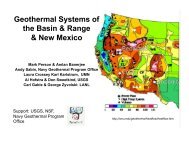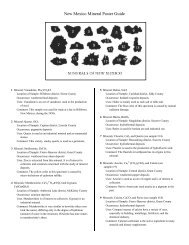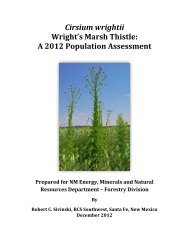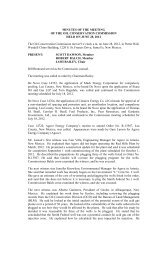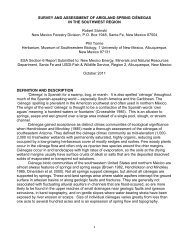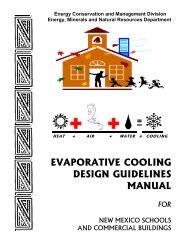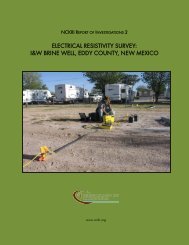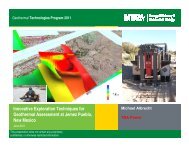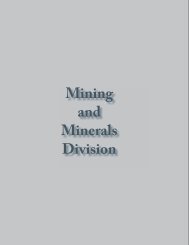Annual Report 3 - New Mexico - Energy, Minerals and Natural ...
Annual Report 3 - New Mexico - Energy, Minerals and Natural ...
Annual Report 3 - New Mexico - Energy, Minerals and Natural ...
You also want an ePaper? Increase the reach of your titles
YUMPU automatically turns print PDFs into web optimized ePapers that Google loves.
Aggregates are a high volume/low unit price commodity <strong>and</strong> track the local economy – they are not tied to the global<br />
markets. Despite the low unit value of its products, the construction s<strong>and</strong> <strong>and</strong> gravel industry is a major contributor<br />
to, <strong>and</strong> an indicator of, economic well-being <strong>and</strong> growth. <strong>New</strong> <strong>Mexico</strong> aggregate production began to decline in 2006.<br />
Aggregate production <strong>and</strong> consumption for residential <strong>and</strong> commercial construction decreased in 2008 <strong>and</strong> 2009 as<br />
the number of building permits decreased <strong>and</strong> the credit market to fund construction tightened. 2009 is projected<br />
to be the bottom of the aggregate production cycle. With funding shortfalls for highways <strong>and</strong> road construction, the<br />
infrastructure sector is expected to experience decreased dem<strong>and</strong> for aggregates in the next several years. Aggregate<br />
dem<strong>and</strong> is expected to remain depressed through 2013.<br />
Increased rail traffic <strong>and</strong> the construction of dual rail lines in southern <strong>New</strong> <strong>Mexico</strong> by Union Pacific Railroad has<br />
led to increased dem<strong>and</strong> for railroad ballast <strong>and</strong> rail bed materials. The start of Spaceport America construction in<br />
2009 has increased aggregate dem<strong>and</strong> in Sierra County. Infrastructure <strong>and</strong> road projects funded by the American<br />
Recovery <strong>and</strong> Reinvestment Act of 2009 may bolster aggregate dem<strong>and</strong>.<br />
The aggregate industry continues to move operations <strong>and</strong> place new operations away from densely populated<br />
centers, where zoning, environmental <strong>and</strong> l<strong>and</strong> development regulations discourage s<strong>and</strong> <strong>and</strong> gravel operations.<br />
Consequently, shortages of construction s<strong>and</strong> <strong>and</strong> gravel in urban <strong>and</strong> industrialized areas are expected to increase,<br />
as are transportation costs associated with s<strong>and</strong> <strong>and</strong> gravel commodities. Increasingly, s<strong>and</strong> <strong>and</strong> gravel operations are<br />
being included in master zoning <strong>and</strong> planning documents for regional areas.<br />
ANNUAL REPORT 2010<br />
95




